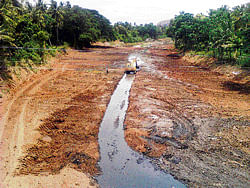
The Arkavathy River was once the lifeline of the region. But all that is left of it today are just fond memories. The river basin that used to boast of 1,775 lakes along its pathway, now has only a few hundreds surviving.
Even during the rainy season, some of the lakes are not filled with water from the basin. The industries along the river stretch and sand mining activity have practically destroyed the river bed, residents claim.
“This basin was once teeming with trees and bountiful water. But now, it is difficult to even trace its course. A few of the dry lakes have turned into garbage dumpyards. In the past one decade, not even one lake has been filled to the brim. Doddaballapur, which is facing severe water shortage due to the depletion of the river, is home to more than 200 industries. All that flows in these lakes are industrial effluents now,” said Doddi Shivaram, who has been fighting to rejuvenate the lake, along with his team.
Shivaram said the water table had been thoroughly contaminated and that the Karnataka State Pollution Control Board had shown little interest in taking action against the owners of these industries.
Residents recall that just 20 years ago, almost every village had a lake to meet its water needs. Even drinking water used to be supplied from the lakes. Now, even growing fruits and vegetables using the lake water is a thing of the past.
The effluents have poisoned the basin beyond repair, thus threatening the lives of the villagers. “The contamination has led to skin diseases and other ailments among the people,” said environmentalist and geologist Dr Lingaraju Yale.
Though the government has banned stone quarrying and sand mining in the basin, there are around 20 industries undertaking these near Nelamangala. The 200 Grama Panchayats along the Arkavathy basin have spent lakhs of rupees for getting water through electric pumps.
“The water at Thippagondanahalli Reservoir is poisonous and is not fit for drinking,” Shivaram said.
The Health Department took water samples from the Thippagondanahalli Reservoir and under the Kithnahalli Bridge. It was found that one litre of water contained 2,390 mg of solid waste. As per the rule, there should not be more than 500 mg of solid waste per litre of water. The water also contained high amounts of chlorides and other toxic compounds. The water here was dark and not fit for human consumption.